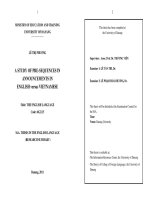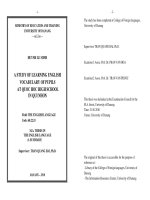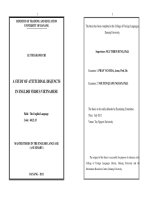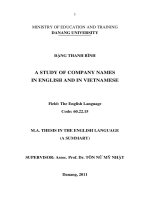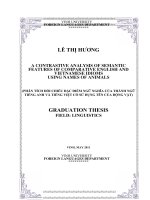Initial study of learning curves in robot-assisted radical prostatectomy
Bạn đang xem bản rút gọn của tài liệu. Xem và tải ngay bản đầy đủ của tài liệu tại đây (640.08 KB, 5 trang )
Life Sciences | Medicine
Doi: 10.31276/VJSTE.61(1).36-40
Initial study of learning curves in robot-assisted
radical prostatectomy
Le Chuyen Vu1*, Vinh Hung Tran2, Phuc Cam Hoang Nguyen2, Van An Nguyen2,
Vu Phuong Do2, Ngoc Chau Nguyen2, Lenh Hung Do3
Medical University of Pham Ngoc Thach, Ho Chi Minh city
2
Binh Dan Hospital, Ho Chi Minh city
3
University of Medicine and Pharmacy, Ho Chi Minh city
1
Received 20 April 2018; accepted 13 February 2019
Abstract:
Introduction
The application of robot-assisted laparoscopic
techniques is new and generates numerous benefits for
patients. Here, we summarise the experience of our
first series through 52 cases of prostate cancer treated
by robot-assisted radical prostatectomy (RARP) in
the Department of Urology of Binh Dan Hospital,
from December 2016 to September 2017, to study
the learning curves of this procedure. In this clinical
comparative study, 52 patients diagnosed with prostate
cancer (clinical stage T1 to T3) received RARP with
and without nerve sparing as well as standard pelvic
lymphadenectomy. Patients were divided into 4 groups
according to their surgeon (surgeons A, B, C, and
D, with 22, 12, 10, and 8 patients, respectively) for
comparison. Research variables were cancer stage, preand postoperative prostate-specific antigen (PSA) serum
levels, Gleason scores, lymph node metastasis, estimated
blood loss, surgery time, urinary incontinence, hospital
stay, and complications. Mean age, PSA, and stage of
cancer were statistically similar (p>0.3). Operative times
were 194.55, 269.17, 236.00, and 306.88 min, respectively
(p<0.01). Mean estimated blood losses were 363.64,
404.17, 322.22, and 253.75 ml, and were significantly
different (p<0.01). Nine patients required blood
transfusion. The lengths of hospital stay were 5.73, 12.92,
5.10, and 6.13 days, and were not similar among groups
(p<0.05); however, drainage times and complication rates
between groups (p<0.01) were statistically significant.
The optimal learning curve for operative times was
achieved after 20 cases. Our initial RARP results were
relatively strong, suggesting that surgery could be safely
performed with acceptable complications.
Radical prostatectomy is considered the gold standard
in treating locally advanced prostate cancer. Currently, 3
main methods of surgery exist: open, classic endoscopic,
and robot-assisted surgery. The application of robot-assisted
surgery is a new step that engenders numerous benefits to
patients. We studied the learning curves (LCs) of robotassisted surgery through 52 cases of radical prostatectomy
performed in the Department of Urology, Binh Dan Hospital,
from December 2016 to September 2017.
Keywords: learning curve, prostate cancer, radical
prostatectomy, robot-assisted surgery.
Classification number: 3.2
Materials and methods
This longitudinal study focused on 52 patients with
prostate cancer (clinical stage T1 to T3) who underwent
robot-assisted radical prostatectomy (RARP) with and
without preservation of neurovascular bundle, as well as
standard pelvic lymphadenectomy. The study variables
were cancer stage, pre- and postoperative prostatespecific antigen (PSA) levels, Gleason scores, lymph node
metastasis, estimated blood loss during surgery, operative
time, and postoperative urinary incontinence. We examined
the improvement of these variables over an 11-month
period, comparing the differences between the 4 console
surgeons: surgeon A (22 patients), surgeon B (12 patients),
surgeon C (10 patients), and surgeon D (8 patients).
Results
Age
Table 1. Age.
Age
All (*)
A
B
C
D
Min
49
55
49
52
62
Max
80
80
79
77
80
Mean
66.27
66.59
64.17
64.40
70.88
SD
8.96
8.12
8.58
7.06
5.82
All (*): means all patients.
*Corresponding author: Email:
36
Vietnam Journal of Science,
Technology and Engineering
March 2019 • Vol.61 Number 1
Life Sciences | Medicine
No differences in age exists between All and groups A,
B, and C. However, group D was older (p<0.05; Table 1).
Preoperative PSA
Table 2. Preoperative PSA (ng/ml).
PSA
All
A
B
C
Drainage time (days)
Table 6. Drainage time.
Drainage time
All
A
B
C
D
Min
1
1
3
1
3
D
Max
35
8
35
11
7
5.67
4.45
9.83
3.70
5.25
4.05
2.15
9.42
2.87
1.49
Min
4.5
7
18
9
5
Mean
Max
100
100
100
100
50
SD
Mean
41.51
43.38
41.00
55.11
22.06
SD
28.81
35.51
24.77
38.07
13.53
Drainage time was different between groups (p<0.05;
Table 6).
Furthermore, no differences existed in PSA levels
between All and groups A and B. Group C had higher levels
and group D had lower levels (p<0.01; Table 2).
Gleason scores and tumour stages
Table 3. Gleason scores.
Gleason
All
A
B
C
D
≥ 3+4
24
11
5
5
3
4+3
8
3
2
2
1
≥ 4+4
20
8
5
3
4
1
8%
5.3%
9.1%
11.1%
14.3%
2
42%
50%
22.7%
38.9%
57.1%
3
50%
44.7%
68.2%
50%
28.6%
Stage
Postoperative hospital stay (days)
Table 7. Hospital stay and complication rate.
Postoperative hospital stay
All
A
B
C
D
Min
2
2
4
3
5
Max
38
11
38
11
7
Mean
7.33
5.73
12.92
5.10
6.13
SD
4.33
2.45
9.70
2.56
0.99
Complications
13/52
4/22
6/12
2/10
1/8
Drainage time differed between groups (p<0.05);
however, it exhibited a close relationship with hospitalised
time and complication rate in each group (p<0.01; Table 7).
No differences existed in Gleason scores between the
groups (Table 3).
Operative time (minutes)
Table 4. Operative time (OT).
OT
All
A
B
C
D
Min
105
120
105
150
225
Max
480
270
480
315
420
Mean
237.02
194.55
269.17
236.00
306.88
SD
69.14
46.72
109.15
60.91
56.06
LCs
500
500
500
400
400
400
300
300
300
200
200
200
100
100
100 0
00
20
20
40
40
20
40
Chart 1. LC
in time
for All.
Chart
1. LC
in time for All.
Chart
1.
LC
in
time
for
All.
Chart 1. LC in time for All.
The mean operative time was equal between All and
groups B and C (p>0.05), whereas it was shorter in group A
and longer in group D (p<0.05; Table 4).
350
350
350
300
300
300
250
250
250
200
200
200
150
150
150
100
100 0
100
0
0
LC in time
5
5
10
10
60
60
60
15
15
5 C.
10
15
Chart 3.
for group
Chart 3. LC
in time
for group
C. for group C.
Chart
3. LC
time
Chart 3. LC
in time
for in
group
C.
Estimated blood loss (ml)
Table 5. Estimated blood loss (EBL).
300
300
300
250
250
250
200
200
200
150
EBL
All
A
B
C
D
Min
80
100
100
100
80
Max
1400
1000
1400
800
700
Mean
345.77
363.64
404.17
322.22
0
10
253.75Chart 5. LC in time
0 for group
10 A.
SD
205.45
209.96
272.01
223.76
in time for group A.
201.35Chart 5. LC
Chart 5. LC in time for group A.
150
150
100
100 0
100
10
Chart 5. LC in time for group A.
20
20
20
30
30
30
500
500
500
400
400
400
300
300
300
200
200
200
100
100
100 0
00
5
5
10
10
15
15
5
10
Chart
time
for for
group
B. B. 15
Chart2.
2.LC
LCin
in
time
group
Chart
2.
LC
in
time
for
group
Chart 2. LC in time for groupB.B.
450
450
450
400
400
400
350
350
350
300
300
300
250
250
250
200
200 0
200
0
Chart 04. LC
5
5
10
10
5 group D.
10
in time for
Chart 4.
4. LC in
time for
group
D. D.
Chart
for
group
Chart 4. LC
LC in
in time
time for
group
D.
290
290
290
270
270
250
270
250
230
250
230
210
230
210
190
210
190 1 3 5 7 9 11 13 15 17 19 21
190 1 3 5 7 9 11 13 15 17 19 21
Chart 6.1 Group
3 5 7A:9cumulative
11 13 15 17mean.
19 21
Chart 6. Group A: cumulative mean.
Chart 6. Group A: cumulative mean.
Chart 6.
Group
A: cumulative
The LCs of All and group A were linear, whereas
those
of groups
B, C, and mean.
D were
The because
LCs of of
Allanand
group Anumber
were linear,
whereas
those of approximately
groups B, C, and
D were
nonlinear
insufficient
of cases.
In conclusion,
20 cases
are
The
LCs
of
All
and
group
A
were
linear,
whereas
those
of
groups
B,
C,
and
D were
nonlinear
an insufficient
number
of cases.
conclusion,
are
required tobecause
achieveofoptimum
efficiency
in terms
of LCsIn(Charts
1-6). approximately 20 cases
nonlinear
because
of
an
insufficient
number
of
cases.
In
conclusion,
approximately
20
cases
are
required to achieve optimum efficiency in terms of LCs (Charts 1-6).
Postoperative
recovery efficiency in terms of LCs (Charts 1-6).
required
to achieve optimum
Postoperative recovery
Early complications
in postoperative recovery included:
Postoperative
recovery
Early
in postoperative
recovery
included:
- Ninecomplications
cases
fluid
collection,
2 cases had to be redrained.
March
2019of•abdominal
Vol.61
Number
1 in which
37
Early
complications
in postoperative
recovery
included:
Nine cases
cases of
of urethral
abdominal
fluid collection,
in which
2 cases had
to be redrained.
- Two
catheters
slipping,
which
necessitated
reinsertion.
-- Nine
casesofof
ofsubcutaneous
abdominal
fluid
collection,
in which
2 cases had
to be redrained.
Two
cases
urethral
catheters
slipping, which
necessitated
reinsertion.
One case
emphysema.
-- Two
casesofofsubcutaneous
urethral
catheters
slipping, which necessitated reinsertion.
One case
emphysema.
acute
myocardial
infarction.
-- One
subcutaneous
emphysema.
acute
myocardial
infarction.
One case of intestinal
occlusion,
which necessitated emergency reoperation.
Vietnam Journal of Science,
Technology and Engineering
Life Sciences | Medicine
The LCs of All and group A were linear, whereas
those of groups B, C, and D were nonlinear because of an
insufficient number of cases. In conclusion, approximately
20 cases are required to achieve optimum efficiency in
terms of LCs (Charts 1-6).
Postoperative recovery
Early complications in postoperative recovery included:
- Nine cases of abdominal fluid collection, in which 2
cases had to be redrained.
- Two cases of urethral catheters slipping, which
necessitated reinsertion.
- One case of subcutaneous emphysema.
- One case of acute myocardial infarction.
- One case of intestinal occlusion, which necessitated
emergency reoperation.
In addition, 16 out of the 52 patients suffered urinary
incontinence from 3 weeks to 2 months postoperatively.
PSA levelswere measured every 3 months after surgery.
In 49 cases, they dropped to a nadir of 0.01-0.4 ng/ml. In
3 cases of stage 3 prostate cancer, we performed salvage
prostatectomy and PSA did not reach ideal levels (4.7, 11.3,
and 14.7 ng/ml). Thus, we had to send these patients to the
oncology department to begin androgen blockade therapy.
Discussion
The prostate gland is an organ of the genitourinary
system; it is small and deep in the pelvis of men. As
previously mentioned, radical prostatectomy is still
considered the gold standard in treating local and locally
advanced prostate cancer. It is used for prostate cancer in
otherwise healthy patients and with a life expectancy over
10 years. Furthermore, it is the most common urology
surgery at present [1, 2].
Open radical prostatectomy for cancer has been
performed at Binh Dan hospital for a long time, although
the number is not high. Since 2000, as endoscopic surgery
has developed worldwide, laparoscopic surgery has
developed quite strongly in our Urology Department. At
the end of 2004, we began employing laparoscopic surgery
for prostatectomy. During the period of 2004-2006, we
performed laparoscopic radical prostatectomy for 23 cases
of prostate cancer. Since then, we have performed over
200 cases using this type of surgery and have published
numerous papers both nationally and internationally
38
Vietnam Journal of Science,
Technology and Engineering
regarding surgical and stitching techniques, patients’ quality
of life, and the value of the predictors of surgery [3-7].
However, this technique has increasingly had
disadvantages exposed, such as a narrow surgical field,
difficult operation, and long LC. When robotic surgery was
born, these drawbacks were minimised, and both patients
and urologists have increasingly advocated this type of
surgery when the patient’s choice of treatment is surgery
rather than radiotherapy [8, 9].
The concept of LCs is a crucial topic in surgery and one
of the less mentioned aspects. Abboudi, et al. [10] presented
a noteworthy article that evaluated the concept of LCs in
urological procedures. Specifically, the authors undertook
a unified approach to systematically evaluate materials
focusing on the LC of some urological procedures, including
primarily radical prostatectomy and partial segmental
kidney surgery.
Most studies have focused on prostatectomy but have
poorly documented their methodological quality, including
a series of surgeries that primarily limited the number of
surgeons and selection of heterogeneous results to study the
LC, focusing on short-term results [11-13].
By contrast, the literature on open surgery or open
prostatectomy is of higher quality, including many large
studies and the application of sophisticated statistical
methods; however, robotic surgery is still preferable. With
these limitations, we concluded that the duration of the LC
for the operative time of robotic surgery is between 50 and
200 cases and the benefit of surgical margin is between 50
and 600 cases. Moreover, urine and erectile control were
reported in 200 cases [10]. Thompson, et al. [14] evaluated
the LC of an open surgeon with experience of more than
3,000 prostatectomy cases before beginning robot-assisted
surgery. The study demonstrated that the effect of the
robot overtook open surgery after 100 cases of sexual
function scores and marginal rates of pT2 cancer, whereas
approximately 150 cases was necessary to achieve urinary
function. In addition, the efficiency of the robot continued
to improve, with scores of sexual function increasing after
600-700 cases and urine continence increasing after 700800 cases. Similarly, the negative margin was stable after
400-500 cases in pT2 and 200-300 in pT3-4. However, no
evidence exists that further improvements can be achieved.
Davis, et al. studied the LCs of more than 71,000
prostatectomy cases in 300 hospitals in the United States,
and between laparoscopic and open radical prostatectomy
March 2019 • Vol.61 Number 1
Life Sciences | Medicine
revealed a longer operative time (4.4 vs. 3.3 hours), shorter
hospital stay (2.2 vs. 3.2 days), and fewer complications
(10.4% vs. 15.8%) for laparoscopic prostatectomy [15].
Other studies have shown improvements in the LCs of
robotic surgeons when robotic surgery is part of formal
residency/fellowships [16], graduate training [17], and/or
regular surgical simulator practice [18]. A study of numerous
surgeons who performed open prostatectomy and robots
demonstrated that robotic surgery has fewer complications,
shorter hospital stays, and reduced blood transfusion rates
[19]. Moreover, the LC is enhanced in robotic arms, which
have been shown to be superior in terms of team work as
opposed to the surgeon’s time undergoing surgery.
Good, et al. [20] studied match cases, comparing 531
open and 550 laparoscopic prostatectomies to investigate the
LCs on blood loss, surgery time, and rate of complications
(Clavien-Dindo grade III). The LC for the overall margin
free rate was longer for the pT2 group than for the
laparoscopy group but was shorter for urinary control. For
apex margins, the long LC for the laparoscopy group and
lower rates for the robot-assisted group (p≤0.001). They
concluded that both methods have a long LC; however,
we found significant benefits in lower margin rates and
early improvements in urinary control over laparoscopy,
particularly in the prostate apex.
In our series, it is too early to draw conclusions about
our LC because of the experience of the console surgeons
of only 8-22 cases. However, it can clearly be seen that
the mean operative time decreased when the surgeon had
more cases and was clearly identified in 20 cases (group
A; Charts 5-6). Furthermore, we observed that the surgeon
with the longest duration of surgery had the least blood loss
(group D, 307 minutes and 237 ml; Table 4-5). One factor
to consider was the correlation between the longest hospital
stay and the highest incidence of complications (group B,
12.9 days, complication 6/12; Table 7). One of this study’s
weaknesses is that it did not investigate the margins of
surgical specimens.
Conclusions
Although the number of patients was low and the followup time was short, our initial results for RARP suggest that
this type of surgery can be performed safely with acceptable
complications. The optimal LC for operative time was
achieved after 20 cases.
The authors declare that there is no conflict of interest
regarding the publication of this article.
REFERENCES
[1] V.L. Chuyen, D.Q. Oanh, T.N.K. Linh (2010), “Mass screening of prostate cancer in Vietnam: status and our opinion”, Urologic
Oncology, 10(6), pp.673-676.
[2] H.T. Dong, V.L. Chuyen (2014), “Epidemiology and prevention of prostate cancer in Vietnam”, Asian Pac. J. Cancer Prev.,
15(22), pp.9747-9751.
[3] V.V. Ty, V.L. Chuyen (2006), “Radical prostatectomy for prostate cancer, Initial experiences at Binh Dan Hospital”, Medical Ho
Chi Minh city, 10(1), pp.136-144.
[4] V.L. Chuyen, V.T. Vu (2006), “Laparoscopic radical prostatectomy for prostate cancer, our experiences in first 23 cases at Binh Dan
Hospital”, Medical Ho Chi Minh city, 10(4), pp.173-182.
[5] V.L. Chuyen, N.T. De (2012a), “Retroperitoneoscopic radical
prostatectomy: factors influencing surgical results”, Medical Ho Chi
Minh city, 16(3), pp.88-92.
[6] V.L. Chuyen, N.T. De (2012b), “Endoscopic extraperitoneal
radical prostatectomy: surgical complications”, Medical Ho Chi Minh
city, 16(3), pp.93-97.
[7] V.L. Chuyen (2013), “Survey the quality of life of the patients
after having the endoscopic extraperitoneal radical prostatectomy”,
Journal of Endoscopic Surgery, 1, pp.51-57.
[8] J.A.Jr Smith (2016), “Radical prostatectomy which patients
benefit most from surgery?”, J. Urol., 176(2), p.437.
[9] V.R. Patel, A.S. Tully, R. Holmes, J. Lindsay (2005), “Robotic
radical prostatectomy in the community setting the learning curve and
beyond: initial 200 cases”, J. Urol., 174(1), p.26972.
[10] H. Abboudi, M.S. Khan, K.A. Guru, et al. (2014), “Learning
curves for urological procedures: a systematic review”, BJU Int., 114,
pp.617-629.
[11] S.B. Farnham, T.M. Webster, S.D. Herrell, J.R.Jr Smith
(2006), “Intraoperative blood loss and transfusion requirements for
robotic assisted radical prostatectomy versus radical retropubic prostatectomy”, Urology, 67(2), p.3603.
[12] M. Froehner, V. Novotny, R. Koch, S. Leike, L. Twelker,
M.P. Wirth (2013), “Perioperative complications after radical prostatectomy: open versus robot assisted laparoscopic approach”, Urol.
Int., 90, p.3125.
[13] C.R. Ritch, C. You, A.T. May, S.D. Herrell, P.E. Clark, D.F.
Penson, et al. (2014), “Biochemical recurrence free survival after robotic assisted laparoscopic vs open radical prostatectomy for intermediate and high-risk prostate cancer”, Urology, 83(6), p.130915.
[14] J.E. Thompson, S. Egger, M. Böhm, et al. (2014), “Superior
quality of life and improved surgical margins are achievable with
robotic radical prostatectomy after a long learning curve: a prospective
single-surgeon study of 1552 consecutive cases”, Eur. Urol., 65,
pp.521-531.
[15] J.W. Davis, U.S. Kreaden, J. Gabbert, R. Thomas (2014),
“Learning curve assessment of robot-assisted radical prostatectomy
March 2019 • Vol.61 Number 1
Vietnam Journal of Science,
Technology and Engineering
39
Life Sciences | Medicine
compared with open-surgery controls from the premier perspective
database”, J. Endourol., 28(5), pp.560-566.
with commercially available simulation systems in 2011: a current
[16] G.B. Di Pierro, P. Baumeister, P. Stucki, et al. (2011), “A
prospective trial comparing consecutive series of open retropubic and
robot-assisted laparoscopic radical prostatectomy in a centre with
limited caseload”, Eur. Urol., 59, pp.1-6.
surgeons”, J. Endourol., 26, pp.283-293.
[17] T.J Leroy, D.D. Theil, D.A. Duchene, et al. (2010),
“Safety and perioperative outcomes during learning curve of robotassisted laparoscopic prostatectomy: A multi-institutional study of
fellowship-trained robotic surgeons versus experienced open radical
prostatectomy surgeons incorporating robot assisted laparoscopic
prostatectomy”, J. Endourology, 24, pp.1665-1669.
ence”, J. Urol., 178(2), p.47882.
[18] C.D. Lallas, J.W. Davis (2012), “Robotic surgery training
40
Vietnam Journal of Science,
Technology and Engineering
review and practice pattern survey from the society of urologic robotic
[19] F. Rozet, J. Jaffe, G. Braud, J. Harmon, X. Cathelineau, E.
Barret, et al. (2007), “ A direct comparison of robotic assisted versus
pure laparoscopic radical prostatectomy: a single institution experi[20] D.W. Good, G.D. Stewart, A. Laird, J.U. Stolzenburg, D.
Cahill, S.A. McNeill (2015), “A critical analysis of the learning
curve and postlearning curve outcomes of two experience- and
volume-matched surgeons for laparoscopic and robot-assisted radical
prostatectomy”, J. Endourology, 29(8), pp.939-947.
March 2019 • Vol.61 Number 1

